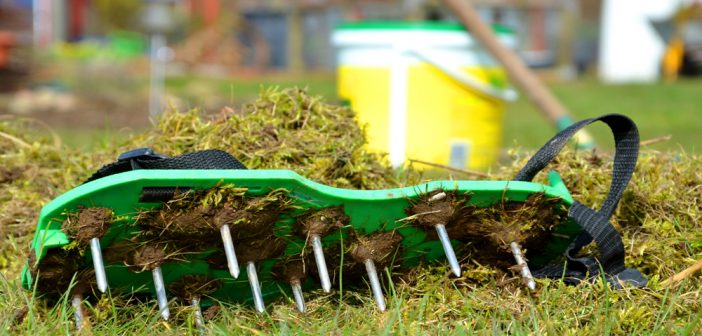Beautiful lawns require maintenance, includes mowing, watering and fertilizing as well as making sure that vital nutrients are able to make their way to the soil beneath your grass. Aeration in particular is a required task because doing so allows water and air to penetrate through lawn thatch or built-up grass. Below is a guide on how to aerate your lawn.
The Basics of Aeration
Aeration is the process of perforating the soil in your lawn with small holes. These holes let nutrients, water and air reach the roots of your lawn, helping them spread deeper into the earth to generate a durable, healthy lawn. The main reason to aerate is to lessen soil compaction. When soil becomes compacted, it has too many particles within a particular space or volume. Too many particles block the proper circulation of nutrients, water and air inside the soil. When lawn thatch or heavy organic debris is present, the lawn’s roots starve from a lack of essential elements.
Aeration works to prepare your lawn’s seed bed. If your grass is a little on the thin side, aeration will help it germinate. Along with the seeds landing in the holes that aeration makes, the soil plugs left on top of the grass will break down, giving the new seed contact with soil. This improves the amount of grass seed that becomes established and starts to grow.
When you aerate, all of the other steps just work better. Weed control, watering, fertilizing and lime application will be more effective when you aerate at the proper time.
How to Determine if Aeration is Needed
Lawns that require aeration generally experience a great deal of use. Children and animals running across the grass contribute to a lawn’s soil becoming compacted. If your lawn was put in when your home was newly constructed, then it probably needs to be aerated. Frequently, home builders strip the topsoil or install grass over soil that construction traffic compacted.
If your lawn has a spongy feel or dries out easily, then this is a sign that it is experiencing an excessive thatch problem. To test for thatch, grab a shovel and dig out a small section of your lawn, going down about 4 inches. If the thatch layer is more than ½ of an inch, you should aerate. Grass that has soil layering because it was established by sod also requires aeration. What is soil layering? It is when finer textured soil, the kind that comes with sod that’s imported, is layered over a soil that has a coarser texture. When it’s layered, water drainage is disrupted because the fine soil holds water inside. This causes compacted soil conditions. It also prevents the lawn’s roots from developing. Aeration breaks up layering, allowing water to move through the lawn’s soil more easily and make its way to the roots.
When is the Best Time to Aerate Your Lawn?
Aerate your lawn when it’s growing. Doing so at this time means that it will have time to heal and fill in the open spaces once the soil plugs are removed. If you have cool season grass, aerate it during the early spring or fall. Shoot for this autumn if possible because the potential for weed growth is less. Warm season grass should be aerated in the late spring.
The Tools for the Job
When it’s time to aerate, you can purchase the tools needed, rent them or hire one of those door-to-door lawn guys to aerate for you. Two main types of aerating tools are a plug aerator and a spike aerator. A plug aerator removes a small core, or plug, of grass and soil from your lawn while a spike aerator simply makes it easy for you to poke holes into the earth using a fork unit or a solid tine. To get the best results, consider investing in or renting the plug kind. Poking holes in the soil is less effective, and in some cases, it can cause more compaction in the areas that are around the holes that you just poked.
Try to get an aerating machine or tool that removes soil sections that measure about 2 inches to 3 inches deep as well as 0.5 to 0.75 inches in diameter. The best aeration tool will also remove these plugs about 2 to 3 inches apart.
Aeration Tips
If you’ve decided to aerate your lawn, a few tips will help you get the best results. Before starting, check the moisture levels of the soil. Make sure it is somewhat moist. Attempting to aerate soil that is bone dry is frustrating. Instead of aerating at the end of a hot, dry week, aerate following a rain storm or the day after you’ve watered your lawn. Most of the time, aeration machines only cover a small amount of your lawn’s soil surface every time you pass over it. Because of this, we recommend that you make several passes over the areas that are the most compacted. Aeration is tough work, so save your resources and your energy levels by going around the areas that are not compacted.
Let the excavated dirt plugs dry. Then, break them apart to give your lawn a clean, even look. You can break them up by pounding them with a shovel or the back of a rake. You can even use a lawn mower, but you may need to sharpen the mower’s blades after running over the soil plugs.
Once you’re done aerating, continue to care for your lawn as you normally would by mowing it regularly, watering it and applying fertilizer. Aerate your lawn once a year, it will make your lawn look better and improve its overall health.
If you want to be “that” neighbor, the one who has the pretty grass, then aerate it. Doing so with the proper equipment, often enough and at the right time of the year will help you grow the pretty, green grass you’ve always wanted.









